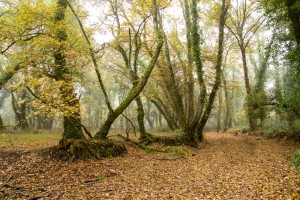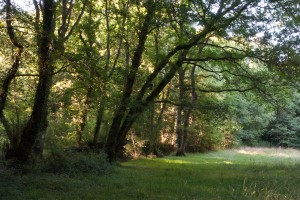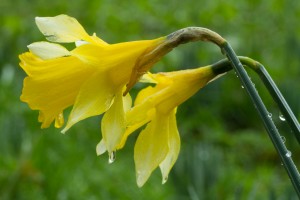Enclave name: San Roque Island 
Protection categories: Inclueded in the SCI Parga-Ladra-ES1120003 Támoga and the Special Protection Area of Parga-Ladra-Támoga Natural Assets
Location: Pertaining to the municipality of Outeiro de Rei, Lugo.
Region: Galicia
Reference Coordinate: 1Km E2898N2392
Surface of the Island: 156 ha.
Altitude: 385 m
In its upper reaches, the river Miño over the last 11,000 years has formed multiple wandering bends which finally originate islands made up of terrigenous material. The largest of these islands is San Roque (or Cela) having a length of 5km and a width of 220m.
The peculiar hydrodynamic conditions of the Island have determined that this enclave hosts a set of important habitats and characteristic species of hygrphilous and aquatic ecosystems. During the winter period a considerable portion of the island is inundated by water, while in the summer season, the water level drops, reaching the surface of the island in its middle area between 120 -200cm above the water level of the river .
The ownership of the wetland corresponds to the provincial council of Lugo, who bought the land for the development of a LIFE project (LIFE 00 NAT_E_007311), establishing the conservation of environmental assets and the public use of space as its principal uses.
All the wetland is within a Site of Community Importance and Special Protection Area Natural Assets, Parga-Ladra-Támoga. Given its conservation interest, this enclave is included within the Area “Protection Area” as reflected in the Master Plan for the Natura 2000 network of Galicia. Therefore this enclave is fully integrated within the core zone of the Reserve Terras de Miño Biosphere.
San Roque Island has an interpretation center in the concello of Rábade, “A Casa das Insuas”, managed by the Galician Association of Custody Territory where information about this space and routes that are available for use public on the island of San Roque can be obtained.
- MORE RELEVANT FEATURES
Singularity
The aquatic vegetation finds this place a favorable area for development, with significant communitites of river vegetation dominated by Ranunculus penicillatus, perfoliatus Potamogeton, P. crispus, Sparganium emersum, characteristic to the habitats of community interest 3260 and 3270. Accompanying these fresh running water habitats other members are emphasized such as the various types of floodplain forests and climax forests (91E0 * and 9230) as well as different types of more or less hygrphilous meadows (6410, 6430 and 6510), all located within the island itself.In addition to these habitats, also present are others more sensitive to changes in use and intensification of farming, such as small seasonal streams that flow through the interior of the islands, megaphorbic eutrophics of the forest boundaries (6430) the low altitude grain fields (6510), and even small aquatic habitats such as temporary surface area ponds associated with river floods (3110).
Codigo Denominación 3110 Aguas oligotróficas con un contenido de minerales muy bajo de las llanuras arenosas (Littorelletalia uniflorae) 3260 Ríos, de pisos de planicie a montano con vegetación de Ranunculion fluitantis y de Callitricho-Batrachion 3270 Ríos de orillas fangosas con vegetación de Chenopodion rubri p.p. y de Bidention p.p. 4020* Brezales húmedos atlánticos de zonas templadas de Erica cillaris y Erica tetralix 6410 Prados con molinias sobre sustratos calcáreos, turbosos o arcillo-limónicos (Molinion caeruleae) 6430 Megaforbios eutrofos hidrófilos de las orlas de llanura y de los pisos montano a alpino 6510 Prados pobres de siega de baja altitud (Alopecurus pratensis, Sanguisorba officinalis) 91E0* Bosques aluviales de Alnus glutinosa y Fraxinus excelsior (Alno- Padion, Alnion incanae, Salicion albae) 9230 Robledales galaico-portugueses con Quercus robur y Quercus pyrenaica In the more shallow and still waters delimiting San Roque Island, diverse species of flora outstanding conservation interest can be observed, being considered as rare or endangered. Resting on the sandy edges are dense populations of Isoetes fluitans, endemic aquatic fern from Galicia, or Nymphoides peltata, both endangered species and included in the Galician Catalogue of Endangered Species. In calmer stretches, or small channels that cross the island, small populations of Luronium natans have also been located, species of Community interest listed in Annex II and IV of the Habitats Directive.
Another species linked to hygrphilous environments, which can also be found on the island, is Narcissus pseudonarcissus subsp. nobilis, which together with Luronium natans form part of the species of Community interest present in this enclave. Narcissus pseudonarcissus subsp. geophyte nobilis is a geophyte of large size (20 -60cm) included in Annexes II and IV of the Habitats Directive, whose distribution is restricted to the territory of the Iberian Peninsula.
Fauna
Among the wildlife that can stand out on San Roque Island is the freshwater pearl mussel (Margaritifera margaritifera), a species of Community interest considered Endangered by the Galician List of Endangered Species present in the channels surrounding the island.Also found in this enclave are bat colonies, detected in the territory is the gardener bat (Eptesicus serotinus), the coastal bat (Myotis daubentonii), the common bat (Pipistrellus pipistrellus), the Goat herder’s bat (Pipistrellus pygmaeus) and the Northern long-eared (Plecotus auritus), all these species are included in the Habitats Directive.
- PHOTOS
-




